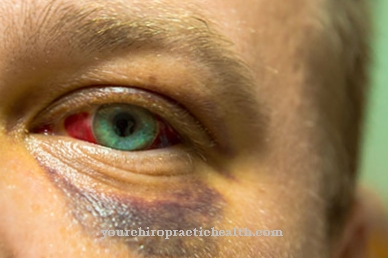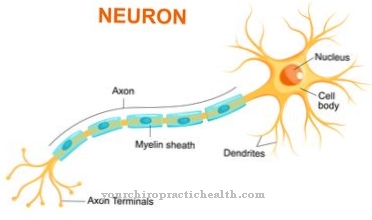Thrombangiitis obliterans or Endangitis obliterans is a chronic inflammatory disease of the small and medium-sized blood vessels which, if left untreated, can lead to necrosis in the surrounding tissue structures of the affected extremity. In particular, men between the ages of 20 and 40 who consume high levels of nicotine (98 percent) are affected by thrombangiitis obliterans.
What is thrombangiitis obliterans?

© ehabeljean - stock.adobe.com
As Thrombangiitis obliterans (also Endangiitis obliterans, Buerger's syndrome, Winiwarter-Buerger's disease) is an inflammatory disease of the arterial and venous blood vessels that is chronic and intermittent.
As a rule, the smaller and middle distal blood vessels of the upper and lower extremities (foot, lower leg, hands, forearm) are segmentally affected by this form of vasculitis (inflammation of the blood vessels). As a result of the inflammatory processes, leukocytes (white blood cells) accumulate on the vessel walls, damage them and later cause thrombosis of the affected vessel, which leads to vascular occlusion and ultimately to necrotization of the adjacent tissue as a result of the reduced blood flow (ischemia).
Thrombangiitis obliterans typically manifests itself in the form of ischemic claudication (limping), resting pain, paresthesia (sensory disturbances such as tingling, numbness, temperature perception disorders), edema, cyanosis (blue discoloration of fingers and teeth) and ulcers (ulcers) or ductic rashes (ischemic necrosis). In addition, thrombophlebitis (acute superficial phlebitis) and Raynaud's syndrome (vasospasm) are characteristic side effects of thrombangiitis obliterans.
causes
The exact etiology of a Thrombangiitis obliterans could not be fully clarified until today. The disease is presumably caused by an underlying genetic predisposition to be autoimmune or allergic-hyperergic and is triggered in combination with certain noxae (exogenous toxins).
In this regard, the antigens HLA-A9 and HLA-B5, which have been increasingly detected in those affected in some studies, are noticeable. In particular, heavy nicotine consumption (smoking) is considered a trigger factor for thrombangiitis obliterans, which can possibly be attributed to nicotine intolerance.
The high incidence among young men who are heavily dependent on nicotine is striking. Hyperhomocysteinemia is also controversially discussed as a potential triggering factor for the disease, although an association has so far only been proven in individual cases. In connection with thrombangiitis obliterans, research is still being conducted into whether the organism of smokers synthesizes autoantibodies against the body's own collagen.
Symptoms, ailments & signs
Thrombangiitis obliterans only affects smokers. It usually begins before the age of 40. Men and women alike can suffer from the relapsing symptoms. In a chronic form, complaints stop by themselves for longer periods of time. This in no way alleviates the causes.
You start again after a vacancy. Typical complaints are pain in the limbs. The hands are often affected. But the feet and calves can also hurt. It doesn't just stop at the pain. Patients complain of a permanent feeling of cold. Bluish fingers and toes indicate this. Sometimes there are superficial skin ulcers. It is not uncommon for the nails to have necrosis. Dying is promoted by poor blood circulation. Sometimes sick people also describe emotional disorders.
Thrombangiitis obliterans can have serious consequences. Whole limbs or their parts can die off. Individual fingers and toes or the entire hand are affected. Patients can then no longer work at a young age. The main complaints about the hands and feet are not exhaustive. The vascular inflammation can spread to other organs. As a result, diseases of the heart, brain and gastrointestinal tract are possible.
Diagnosis & course
A Thrombangiitis obliterans can often be diagnosed from the characteristic clinical symptoms. Color-coded duplex sonography enables the flow rate of the blood as well as the adjacent tissue structures to be displayed.
Magnetic resonance angiography can detect vascular anomalies such as constrictions or occlusions, while phlebography (x-ray of the veins under contrast agent) can show obstacles to outflow (e.g. thrombosis). A biopsy is only performed in unclear cases due to the increased risk of wound healing disorders in suspected thrombangiitis obliterans. In terms of differential diagnosis, the disease should in any case be differentiated from other vasculitis, arterial embolism, peripheral arterial occlusive disease and venous insufficiency.
Thrombangiitis obliterans has a favorable prognosis in terms of life expectancy. With regard to the preservation of the affected extremities, the prognosis is considerably less favorable, especially if the patient does not stop smoking. Later amputation is required in around 40 percent of those affected by thrombangiitis obliterans.
Complications
Thrombangiitis obliterans can lead to serious complications. Typical for the vascular disease are sensory disturbances and pain that persist in the absence of or too late treatment. The typical blue coloration of the skin, cyanosis, can develop into a so-called polyglobulia if it is chronic. This then leads to iron deficiency anemia and the resulting chronic exhaustion.
Cyanotic patients also have an increased tendency to bleed and often develop brain abscesses. If necrosis occurs, this can lead to organ damage. In around 40 percent of cases, one or more extremities have to be amputated in the course of the chronic inflammatory disease. A possible secondary disease of thrombangiitis obliterans is Raynaud's syndrome, which is associated with further pain as well as reddening of the skin and scleroderma. Therapy for the disease can be associated with side effects and interactions.
The typically prescribed analgesics cause gastrointestinal problems and skin irritations, for example. Antirheumatic drugs, antibiotics and platelet aggregation inhibitors also harbor corresponding risks.Serious complications are only likely with complex surgical procedures such as bypass surgery or an amputation. Despite all measures, there is always the risk that the thrombangiitis obliterans will recur elsewhere.
When should you go to the doctor?
The affected person is dependent on medical treatment for thrombangiitis obliterans. Only correct and, above all, early treatment can prevent and limit further complications or complaints, as this disease cannot heal itself. For this reason, a doctor should be consulted at the first signs and symptoms of the disease.
With thrombangiitis obliterans, very severe pain in the limbs usually indicates the disease. The hands are particularly affected by this pain. However, there is also a reduced blood flow, which can also lead to necrosis. Most patients also suffer from sensory disorders, which can lead to restrictions in everyday life. In some cases, thrombangiitis obliterans can also cause inflammation of the internal organs.
Thrombangiitis obliterans can be recognized and treated by a general practitioner or an internist.
Treatment & Therapy
As part of the therapy of a Thrombangiitis obliterans strict abstinence from nicotine has absolute priority, as this alone can stop the progress of the disease.
Although impairments that are already present are usually irreversible, in around 94 percent of people abstaining from nicotine can avoid additional amputations in the further course. With the help of analgesics or NSAIDs (non-steroidal anti-inflammatory drugs), the pain can be reduced, whereby, in the case of pronounced pain, a temporary pain relief through an epidural anesthesia can be considered.
In addition, the aim is to reduce the amputation rate by improving the blood circulation in the affected extremities through pressure relief (immobilization), platelet aggregation inhibitors (e.g. acetylsalicylic acid) and intravenously infused prostaglandin derivatives (e.g. iloprost, alprostadil). The latter also reduce the pain at rest and significantly accelerate the healing of necrotic tissue. Necrotic structures and fibrin coatings should be removed, and open wounds should be treated prophylactically against infections by regular rinsing.
If signs of infection can be detected, antibiotic therapy may be indicated. The long-term effect of a sympathectomy (operative nerve block) has not yet been proven, although it may be possible due to its spasm-relieving effect. In very rare cases, if there is severe ischemia, bypass surgery can be performed. In addition, it is recommended that those affected by thrombangiitis obliterans avoid exposure of the fingers and toes to cold and heat baths.
You can find your medication here
➔ Medicines for smoking cessationprevention
As the exact cause of a Thrombangiitis obliterans is not clarified, this cannot be prevented. By strictly abstaining from nicotine, however, the manifestation of the disease can be prevented or the progression of thrombangiitis obliterans can be brought to a standstill.
Aftercare
As a rule, various follow-up measures are necessary for thrombangiitis obliterans. These differ depending on the course of the disease and the therapy chosen. Quitting nicotine consumption immediately often leads to healing. However, in the case of heavy smokers, the cessation process should be medically monitored.
Therefore, regular check-ups with your family doctor or a specialist are advisable. The intervals between follow-up visits can vary widely. Often there is a strong craving for nicotine for months and years after quitting smoking. It is advisable for those affected to consult a family doctor in such cases.
Psychotherapeutic support is sometimes necessary. In advanced thrombangiitis obliterans, infusion therapy is often necessary. This usually requires an inpatient hospital stay, during which some follow-up examinations are already carried out. If the course is uncomplicated, at least one further check-up is usually necessary a few weeks later.
In most cases, ultrasound and x-rays are taken of the affected area. In a few cases, thrombangiitis obliterans requires amputation. Follow-up care is far more intensive and lengthy than with a more favorable course of the disease. The healing of the surgical wound is initially closely monitored. A longer hospital stay is therefore necessary. This is followed by further measures to regain mobility.
You can do that yourself
There are a number of things people can do for themselves. However, if possible, a doctor should be asked before use.
Home remedies that can cool and regress the inflammation are alcohol packs and apple cider vinegar. To do this, apple cider vinegar or alcohol from the pharmacy should be diluted with water. With this, cloths are soaked and wrapped around the affected areas. This has a particularly cooling effect. Clay packs are also an old home remedy. For this purpose, clay should be mixed with cold water to form a paste-like mixture and then applied to the affected areas as thick as a finger. This has primarily anti-inflammatory and decongestant effects.
The disease is associated with smaller blood clots. Accelerated blood circulation often helps to dissolve this. Exercise and support stockings or a compression bandage lead to the regression of blood clots. The pulse rate increases with movement. The heart then pumps more blood and speeds up blood circulation. Support stockings and compression bandages compress the affected veins somewhat and thus reduce the cross-section of the veins. The same amount of blood must then flow in the narrowed cross-section of the vein. This increases the flow rate. Compression also significantly improves the function of the venous valves and thus the function of the venous pump.
Nevertheless, a doctor should always be consulted, since in the worst case the disease can lead to a life-threatening pulmonary embolism.


.jpg)



.jpg)

















.jpg)



